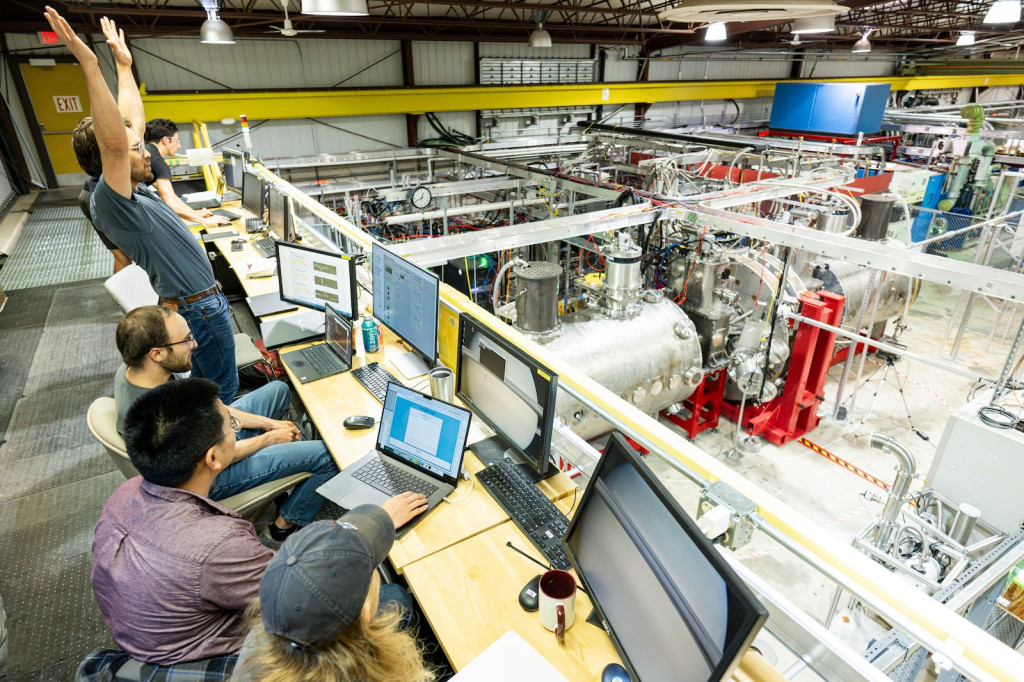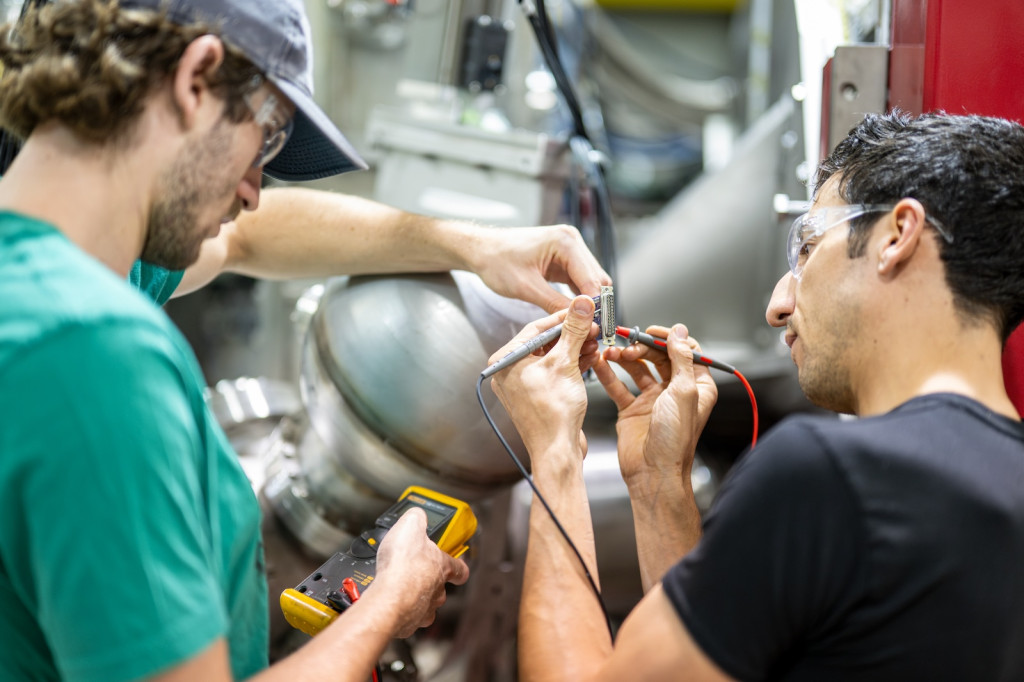First plasma marks major milestone in UW–Madison fusion energy research

Elliot Claveau, honorary fellow in the Department of Physics and experimental scientist at Realta Fusion, raises his hands in celebration of achieving a plasma from the control room at the Wisconsin HTS Axisymmetric Mirror Project (WHAM) experiment being conducted at the Wisconsin Plasma Physics Laboratory in Stoughton on July 16, 2024. Photo: Bryce Richter
Research at the University of Wisconsin–Madison drives innovation, saves lives, creates jobs, supports small businesses, and fuels the industries that keep America competitive and secure. It makes the U.S.—and Wisconsin—stronger. Federal funding for research is a high-return investment that’s worth fighting for. Learn more about the impact of UW–Madison’s federally funded research and how you can help.
STOUGHTON, Wis. — A fusion device at the University of Wisconsin–Madison generated plasma for the first time Monday, opening a door to making the highly anticipated, carbon-free energy source a reality.
Over the past four years, a team of UW–Madison physicists and engineers has been constructing and testing the fusion energy device, known as WHAM (Wisconsin HTS Axisymmetric Mirror) in UW’s Physical Sciences Lab in Stoughton. It transitioned to operations mode this week, marking a major milestone for the yearslong research project that’s received support from the U.S. Department of Energy.
“The outlook for decarbonizing our energy sector is just much higher with fusion than anything else,” says Cary Forest, a UW–Madison physics professor who has helped lead the development of WHAM. “First plasma is a crucial first step for us in that direction.”
WHAM started in 2020 as a partnership between UW–Madison, MIT and the company Commonwealth Fusion Systems. Now, WHAM will operate as a public-private partnership between UW–Madison and spinoff company Realta Fusion Inc., positioning it as a major force for fusion research advances at the university.
The promise of fusion energy
Like fission, its nuclear energy counterpart, fusion produces carbon-less byproducts, making it one of the cleanest potential energy sources in terms of greenhouse gases. Fission, however, produces long-lived radioactive byproducts that must be safely stored for long periods of time.
Fusion’s fuel — the inputs of the reaction — are abundant and relatively cheap: deuterium, a form of hydrogen with one neutron that is found in seawater, and lithium, an element needed in an amount that is mere fractions of what is required for today’s lithium-ion batteries. These are used to create the radioactive isotope tritium. Then fusion occurs when a heated plasma of deuterium and tritium ions is magnetically moved at rapid speeds in a reactor. The ions collide and fuse their nuclei, releasing energy. That energy is captured as heat, which can be used for industrial heating processes or converted to electricity.
“We think fusion will be as good at producing electricity as any energy source would be, and we think it might be even better to use it as a source of industrial heat for making things,” Forest says. “The world makes more carbon and uses more energy making things than it does moving things or turning the lights on. If we’re going to solve the climate change problem, we should probably be focused even more on how we make things than how we move things.”
A major advance in fusion
Fusion occurs naturally in our sun and other stars to create heat and energy. And for decades, researchers have tried to replicate this process with fusion devices known as mirror machines.
Fusion is most efficient when the plasma is physically contained, as the charged particles have a better chance of colliding. Mirror machines try to limit the escape of the particles from the main reactor with inward-facing magnets. But an inability to efficiently contain the plasma — and therefore to achieve net-positive energy production — had greatly limited the function of the machines until recently.
Over the last decade, researchers around the world have developed high-temperature superconductor magnets that are tens of times stronger than the magnets previously used for fusion research. And with these powerful magnets, the UW–Madison team is revisiting mirror machines as plasma energy reactors.
Since 2020, UW–Madison, MIT and Commonwealth Fusion Systems have received $10 million in grants from the U.S. Department of Energy to build WHAM, in addition to funding support from the UW–Madison College of Letters & Science and UW’s offices of the Vice Chancellor for Research and the Vice Chancellor for Finance and Administration. Commonwealth Fusion Systems has been developing the magnets while UW–Madison has been building the mirror machine. After receiving the magnets earlier in the month, UW–Madison researchers achieved first plasma on July 15, the first step in a new age of fusion research at the university.
Preparing fusion energy for market
First plasma marks the transition from building to operations, and the very beginning of the discovery phase of the research. It is also an important step in a public-private partnership with Realta Fusion, a UW–Madison spinoff that will focus on commercializing mirror fusion. In June 2023, Realta was one of eight companies selected for Department of Energy milestone funding. Forest, a co-founder of Realta, compares the milestone program to the one that NASA used to develop a commercial space program with companies such as SpaceX. Realta has provided both funding and staffing to bolster the WHAM project.
“WHAM is a unique experiment, setting a world record in magnetic field strength for magnetically confined plasmas and equipped with intense heating systems while still being a hands-on experiment for both graduate and undergraduate students,” says Jay Anderson, a scientist at UW–Madison and co-founder of Realta. “Realta over the last year and a half has really amplified what the UW team been able to accomplish.”
The WHAM team will now jump into the discovery phase, learning as much as they can about improving efficiency and setting the stage for what comes next.
“We want to find the showstoppers,” says Forest. “Can we build the magnets? Can we increase the stability of the plasma, which is inherently unstable? How well can we confine the plasma? These questions will take several years to address well, and if we can understand and predict everything about this device, then it will provide the foundations for the next device, the break-even device.”
Support for this research was provided by the U.S. Department of Energy’s (U.S. DOE) Advanced Research Projects Agency – Energy (ARPA-E) award DE-AR0001258; by the University of Wisconsin–Madison, Office of the Vice Chancellor for Research with funding from the Wisconsin Alumni Research Foundation College of Letters & Science and Office of the Vice Chancellor for Finance and Administration; and by Realta Fusion, Inc. Other support, in the form of loaned, gifted, or repurposed equipment came from Commonwealth Fusion Systems, Fermi National Accelerator Lab, General Atomics, Los Alamos National Lab, Max Planck Institute of Plasma Physics (Greifswald), Massachusetts Institute of Technology, TAE Technologies, U.S. Department of Energy, and the University of Wisconsin–Madison Physical Sciences Laboratory.







